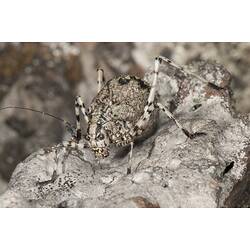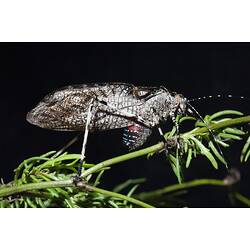General Description
Female squat, long-legged and flightless; male more elongate and with fully-formed wings. Both sexes have long, wispy antennae. Colour mottled grey-brown, cream-white and black, but with bands of crimson and blue - normally hidden - along the edge of each abdominal segment. Body-length up to 5 cm.
Biology
These insects feed mostly on fireweeds and other herbs, from which they may assimilate toxins that make them distasteful to predators. They rely on camouflage to avoid detection. When threatened, females freeze while males emit a warning call. If further threatened, the wing-covers are raised and the abdomen arched and vibrated, revealing otherwise hidden bands of shimmering crimson and electric blue. Males also sing when defending territory or courting.
Distribution
Eastern Australia.
Habitat
Mostly high-altitude grasslands, heathlands and woodlands.
More Information
-
Animal Type
-
Animal SubType
-
Brief Id
Wispy antennae, mottled grey-brown, abdominal bands of crimson and blue, body-length to 5 cm.
-
Colours
Black, White, Grey, Red, Blue
-
Maximum Size
5 cm
-
Habitats
-
Diet
Herbivore
-
Hazards
Usually harmless, but can bite.
-
Endemicity
-
Commercial
No
-
Conservation Statuses
CITES: Not listed, FFG Threatened List: Not listed, EPBC Act 1999: Not listed, IUCN Red List: Not listed
-
Taxon Name
-
Common Name
Mountain Katydid
-
Kingdom
-
Phylum
-
Subphylum
-
Class
-
Order
-
Family
-
Genus
-
Species Name
reticulata












